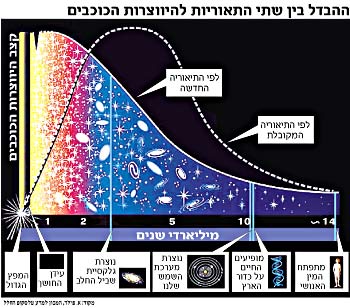Contrary to the opinion accepted by most astrophysicists, according to which the first stars were formed at a slow pace, some researchers now believe that the stars were formed in a sudden and fast burst - like a barrage of De Noor fireworks that lit up the dark universe at once
 By: Tamara Traubman
By: Tamara Traubman
Contrary to the opinion accepted by most astrophysicists, according to which the first stars were formed at a slow pace, some researchers now believe that the stars were formed in a sudden and fast burst - like a barrage of De Noor fireworks that lit up the dark universe at once. This, based on a renewed analysis of observations of distant galaxies carried out by the "Hubble" space telescope.
The findings were reported yesterday by the head of the research team, Kenneth Lanzetta, a professor of astrophysics at the State University of New York at Stony Brook, at a press conference held by NASA. A report describing his research is expected to be published in the next issue of the scientific journal "The Astrophysical Journal".
Prof. Lanzetta bases his conclusions on an analysis of observations made in 1995 and 1998 by Hubble. In the observations, celestial bodies are seen to be very far away and therefore very early (since the farther away the celestial body is, the longer it takes for light to reach the Earth). Therefore, the observations provide information about the early universe, only a few hundred million years after the "big bang", the moment when, according to the theory, the universe was created - about 14 billion years ago.
Reactions from the cosmological community were mixed. Dr. Lisa Storey-Lombardi from the California Institute of Technology, told the "New York Times" that in her opinion the findings do indeed reflect the first period of star formation. Prof. Yoel Rafaeli from Tel Aviv University said that Prof. Lanzetta did a "careful and high-quality" analysis, but it is likely that the results will be controversial due to the fact that his calculations are based on measurements that require precision, and Lanzetta himself also said that his conclusions need confirmation from additional observations.
"These studies belong to the type of things that are very important and interesting - if they turn out to be true," said Prof. Mario Livio in a telephone interview from his office at the Space Telescope Science Institute, which is responsible for Hubble's scientific missions.
Lanzetta and his colleagues were actually required to answer the question, at what point in time the rate of star formation reached its peak. Their calculations were based on an analysis of the color of the ultraviolet light emitted from the most distant galaxies that Hubble was able to photograph, and on variables such as the average intensity of light emitted from massive and very bright stars, the current rate of star formation and the density of gas in the universe.
The researchers deduced the number of "missing stars", which do not appear in the photographs and which, according to their hypothesis, should exist, in the following way: if a person peeking at a party through a high fence wants to estimate the number of participants, he uses the number of tall people visible through the fence.
"If all you can see are people taller than 1.85 meters, and the average height of the participants is known, it can be concluded that there are many more people at the party who cannot be seen," the researchers said in a statement.
In a quite similar way, Prof. Lanzetta and his colleagues concluded that the objects that can be seen in the most distant Hubble photographs are only the "tip of the iceberg". In the Hubble photographs of the early universe, only the brightest galaxies were visible, but Lanzetta believes that at that time many distant stars were formed whose light is difficult to perceive on Earth.
However, the calculations indicated several possible scenarios, but the research team preferred the scenario that the rate of star formation peaked when the stars began to form, a few hundred million years after the Big Bang.
As mentioned, the accepted hypothesis among most astrophysicists assumes that in this initial period, the rate of star formation was rather slow, and only when the universe reached about half of its current age, the rate reached its peak.
What could have decided between the two theories, according to experts, is a spectroscopic analysis (which makes it possible to identify the composition of the material and learn about the distance of the galaxy from us) of the light emitted from the distant stars. But the light coming from those stars is too weak to be tested this way. "This will probably only be possible when we place the 'next generation' telescope in the sky (a powerful telescope being built by NASA, 2008)," Livio said, and this will perhaps only happen in XNUMX.
The knowledge site was until 2002 part of the IOL portal
